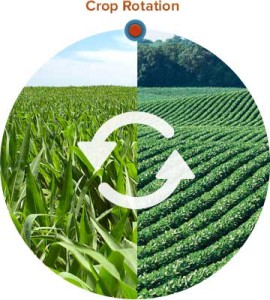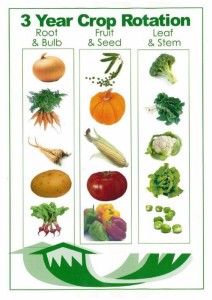The phenomenon of growing more than one type of crop on a single piece of land in chronological seasons is called crop rotation. This tactic has been employed by farmers for many years to preserve the fertility of the soil as well as to yield good produce all year round. The early traces of crop rotation were seen in the Middle East and Rome, but the farmers then did not have an idea of its profound benefits. Gradually realizing its many advantages, crop rotation has become immensely popular among farmers throughout the world. It is a sustainable way of crop production and soil preservation. Crop rotation is being employed in many farms across the world- big or small alike. It is estimated that there is an increased yield of up to 25% when crops are rotated in place of monoculture.
Crop rotation can be carried out with five to six numbers of different crops throughout the seasons. However a two-crop rotation is the most common type of crop rotation seen in farms. Intensive cropping is another feature of crop rotation. Before crop rotation can be carried out, some factors need to be determined. They are as follows-
- The selection of the crops according to the soil type. If the soil is too shallow, big rooted crops like corns, potatoes or tomatoes cannot be grown. This limits the choice somewhat.
- Total labour cost of the entire operation. The initial investment may not be small, but the profits far exceed the investment.
- Net profit at the end of each produce.
- The occurrence of weeds, pests and diseases would have to be taken into account.
- The effect that one set of crops would have on the succeeding ones. Each crop has to be examined properly.
- Availability of livestock in the farm.
- Nutritional need and growth pattern of the crops. Each crop has different and unique behavioural patterns.
- Climate and market demand are some other factors that influence the selection of crops for crop rotation.
Not all crops complement each other. A detailed study of the growth pattern and nutrient requirement of each crop is essential before crop rotation can be started. There are certain crops like corn, tomatoes or leafy vegetables like cabbage lettuce that suck up a lot of nutrients from the soil. They also tend to feed on phosphorous from the soil. Now if these crops are grown in repeated successions every year, it won’t be too long before the soil loses all its nutrients and becomes infertile. To prevent this from happening, farmers have come up with crop rotation where they alternate the tomatoes and corns with nitrogen fixing leguminous plants like beans or peas. This way the soil is replenished- ready for the corn or tomatoes to be planted again.
The various benefits of crop rotation can be summed up as follows-
- Fertility of the soil is improved to a large extent. The land is put to use instead of letting it lie fallow for months. This improves the soil fertility by leaps and bounds.
- Production costs are less. No additional fertilisers are required when crops are rotated. When one crop feeds on the nutrients of the soil, the other crop balances it by injecting nutrients to the soil.
- The spreading of pests, diseases and weeds is curbed.
- Leguminous plants contain a certain kind of nitrogen-fixing bacteria named rhizobia bacteria. This bacterium fixes atmospheric nitrogen in the soil, making it healthy and fertile. The addition of nutrients to the soil helps it thrive, so that when other plants that require nitrates are grown, no additional fertilizers are necessary.
- With repeated crop rotation, chronic soil-borne diseases like fusarium wilt or anthracnose fungus are kept at bay.
With so many profound benefits, it is no surprise that crop rotation yields more profit than traditional monoculture.
Although crop rotation may appear easy, in execution it is not so. Sometimes crop rotation does pose some minor problems to the farmers. If the farming area is small, big plants cannot be grown there. Rotating big plants becomes a major problem here. On top of that the farmer may have to face shading problems. Moreover, commercial farms don’t exactly profit a lot from crop rotation- the reason being that the production of their highest yielding crop declines due to the growing of other crops. To add to that, sometimes the cost of tools and machinery also tends to be a little high when so many different numbers of crops have to be tilled. It is not possible for a poor farmer to invest in so many types of machineries. Farming loans can be taken in such situations.
Although crop rotation does bring to the fore a few minor problems, they can be managed with proper skill and expertise. Crop rotation is an art which requires a lot of study. Initially when a farmer decides to rotate crops, he has to study farming techniques, growth patterns of different crops and various other factors. A farmer must be able to tackle any problems that may arise during the cultivation of each crop. If successfully managed, crop rotation can earn huge profits within a year.



Leave a Reply